Attitude is Everything at a Tradeshow
A Positive Attitude Makes a Difference to the Exhibitors
A few weeks ago, I had an opportunity to supervise set up of an exhibit for one of my clients at the National Space Symposium in Colorado Springs. Now this is not a large show, and the exhibits aren’t massive, but the show was pretty cool.
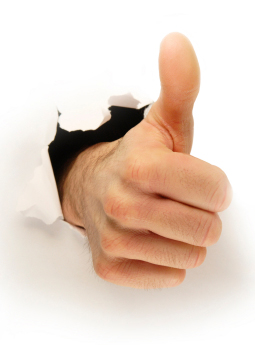 The products that were being shown were very interesting in their own right, and the fact that the show was held at the Broadmoor Hotel (a world famous 5-star facility) also contributed to the experience. I don’t think the Broadmoor hosts very many trade shows, but in any case, this one has got to be the largest one they do host. The attendees are predominately military or government employees. The exhibit space is spread across two halls, but naturally, all of the exhibitors all want to crowd into the main exhibit hall.
The products that were being shown were very interesting in their own right, and the fact that the show was held at the Broadmoor Hotel (a world famous 5-star facility) also contributed to the experience. I don’t think the Broadmoor hosts very many trade shows, but in any case, this one has got to be the largest one they do host. The attendees are predominately military or government employees. The exhibit space is spread across two halls, but naturally, all of the exhibitors all want to crowd into the main exhibit hall.
While the hotel and the view of Pike’s Peak is beautiful, in my opinion the most impressive thing about this show was the attitudes of the people working on the showfloor. As set up began, we were all crushed into the main hall. Moving a crate to get to the lid meant moving several crates. The general services contractor (Freeman) struggled to get crates delivered and empties removed. Even in the face of all these difficulties, there was very little stress. I had a problem with the rental carpet that caused a minor delay, which was corrected immediately. The spirit of cooperation and productivity was amazing. Everyone worked hard, was courteous and friendly, and offered to help without being asked no matter which company they were working for.
No one was walking the aisles telling us what we were and weren’t allowed to do. The entire workforce seemed to be thankful for the opportunity to have the work and helped out whenever possible.
I am not sure why attitudes seemed so upbeat, but I can tell you that it makes a big difference to the exhibitors. As cities like Chicago try to find ways to retain trade shows, perhaps they should consider what they can do to change the attitudes of all workers on the show floor.
Trade Show Exhibit Strategies: Be the “Talk of the Show”
Become the “Talk of the Trade Show”
Every show has that one exhibitor that everyone talks about – the “Talk of the Show”. It is not always the biggest or most expensive booth, but it is often the booth that has the best marketing idea. Here are some ways that unlikely exhibitors became the “Talk of the Show”:
- Rare autographed merchandise that appeals to the target customer.
Pick the right item and the right celebrity for your target customer and, if used as part of a themed exhibit and contest, your exhibit could be a show standout. Select a rare, one-of-a-kind item to be used in a prize drawing, add some related, less expensive items to make the contest more exciting. Then come up with a themed contest and exhibit to make the entire concept and booth an entertainment event. - Film a live show and make attendee the stars.
Most people love to see themselves on camera. Set up a Live Cam and Web Cam from the show floor and put on a show. Broadcast your “show” on monitors so people can watch their colleagues be stars. At one trade show, an exhibitor created a talk show set and broadcast live at the trade show and online. They had a “band” with a couple of musicians and recorded music, a show host and invited attendees to be their guests on the show. Guests could be interviewed about the product or sing favorite songs with modified lyrics that integrated the featured product. The program got the highest ratings at this show. - A housewares magic act.
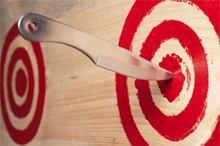 Many exhibitors hire magicians or entertainers to attract exhibit traffic, but every now and then a company comes up with an act that breaks out of the ordinary. A ceramic knife manufacturer took a knife throwing act to a new level – pitting their ceramic knives against the competition. The knife throwing act demonstrated that while some ceramic knives shattered easily, the company’s knives were truly shatter resistant and could survive even knife throwing.
Many exhibitors hire magicians or entertainers to attract exhibit traffic, but every now and then a company comes up with an act that breaks out of the ordinary. A ceramic knife manufacturer took a knife throwing act to a new level – pitting their ceramic knives against the competition. The knife throwing act demonstrated that while some ceramic knives shattered easily, the company’s knives were truly shatter resistant and could survive even knife throwing. - Extreme Demos.
If you have an extreme product, consider having an extreme demo. At one trade show, Taser offered to shock attendees, and hundreds took up the offer and ended up on the floor. - Great food.
If you are exhibiting at a non-food show, think about offering a crowd-pleasing, made-to-order food item. The trick is to avoid the commonly offered freshly baked cookies and coffee drinks. For example, at a tech show, Fios, Inc. of Portland offered smoothies – and had people lined up for hours. While attendees waited for their smoothie, the booth staff scanned their badges and introduced attendees to Fios e-discovery legal support services and software.
There are many ways to attract attention – prizes, demos, entertainers and free food are common – but when done in an unexpected way, it can make your booth the trade show exhibit that everyone talks about.
Shine Like a Star at Your Trade Show by Scheduling a Book Signing
Schedule a book signing at your next trade show
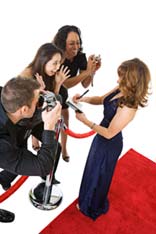 Our clients are constantly looking for new ways to drive more traffic to their trade show exhibit. One very effective method to accomplish this is to schedule a book signing.
Our clients are constantly looking for new ways to drive more traffic to their trade show exhibit. One very effective method to accomplish this is to schedule a book signing.
Most industries have some well-recognized experts who have written books or white papers on subjects directly related to the show and to exhibitors’ products or services. The opportunity to meet and talk to one of these experts as well as walk away with an autographed copy of a book can be a very compelling attraction.
This type of promotion works particularly well in medical, scientific and technical shows. The authors are very often participating in the show as speakers or presenters so the cost of having them in a booth can be quite reasonable. They are often willing to work the booth for just the cost of the books.
Be sure to hype the book signing with preshow emails to attendees. Develop a lead card that gathers all of the information necessary to turn the lead into a sale. The attendees should be required to complete the lead card in order to receive the book.
Consider controlling traffic by making it a “by invitation only” event in your pre-show promotions.
Trade Show Exhibit Design: It pays to “Think Big”
If you want a Trade Show exhibit that is memorable and persuasively communicates your brand, keep it focused on one overarching idea. Think Big. Create a “Big Idea”.
 When a prospect walks into a Trade Show they are confronted with hundreds – even thousands of different marketing messages. If you are lucky, your company will have 15, maybe even 30-seconds to capture that prospect’s attention.
When a prospect walks into a Trade Show they are confronted with hundreds – even thousands of different marketing messages. If you are lucky, your company will have 15, maybe even 30-seconds to capture that prospect’s attention.
The less you try to say, the more people remember.
One way to break through the competitive clutter is to have a single-minded message – a simple statement that sums up the most important thing you can say about your company that will convince a prospect to consider buying your product – and then to communicate this message with creative that is attention-getting and memorable. This is often referred to as a “Big Idea”.
What if your company doesn’t have a single-minded message?
Sometimes the answer is already part of your company’s marketing program. For most companies, particularly B2B firms, I have found that there is no single-minded message in the advertising and marketing communications. Usually, there is a well thought out graphics standard, a nice logo and tagline, and some positioning and benefits copy on collateral and the company’s website.
If your company doesn’t have a single-minded message, develop it. Look for a key insight about your brand. Start with your customers’ buying behavior to discover one significant reason why customers buy – or why they don’t buy – from your company.
Then answer this “simple” question, “What is the one thing we want to say to our target customer to convince them to buy from us?”
Ask the people who work with you the question. Sometimes the head of Sales and Marketing can answer the question immediately. But if no one can answer the question, answer these three questions:
- Why do you need a big idea?
- What is the problem you are trying to solve?
- Why does the problem exist?
Then sum up the answers into a one sentence response that answers the question, “What is the one thing we want to say to our target customer to convince them to buy from us?”
How can you come up with a “Big Idea”?
Once you have a single-minded message, you can start to work with your creative team to create a “Big Idea” that powerfully communicates the message. A good place to start is to select an exhibit marketing support firm that has the capability of working with you to craft this “Big Idea” and to align every aspect of your trade show effort to support the “Big Idea”.
Communicate this “Big Idea” in every element of your trade show exhibit – from the graphics and exhibit to the people who are staffing your booth to promotional materials – make sure that everything is building an attention-getting, memorable message.
You can incorporate your “Big Idea” into all the elements of your trade show program:
- Exhibit theme
- Live presentations
- Traffic building attractions
- Booth staff
- Pre-show promotion
- Lead response and follow-up
Does your company have a single-minded message? Has your exhibit marketing support firm delivered a big idea for your company?
Dismantle: Where Tradeshow Exhibit Damage is Done
Reduce Damage to Your Trade Show Exhibit During Post-Show Dismantling
Most tradeshows are open for 3 or 4 days. If you have ever been on the show floor during the last 2 hours of the show, you will see an amazing transition take place.
One week earlier there was an air of excitement and urgency as the exhibit crates were delivered to the booth spaces. Installation crews worked against the clock to get everything just right prior to the show opening. The night before the show, crews remove all of the empty crates and trash and roll out the aisle carpet. As the show opens, the sales staff arrive at their booths in their crisp business attire, anxious to grab anyone with an attendee badge and make their pitch.
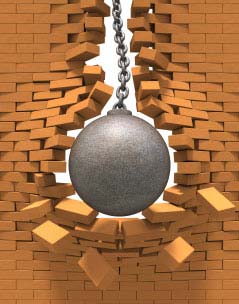 In contrast, by afternoon on the last day of the show, the booth staff is tired, the traffic is light and everyone is ready to rush to the airport. Often, the booth staff will be required to stay after the show closes and take down the booth. It is sufficient to say they most likely will not use the same care in taking the booth down as they did in setting it up. Expensive display components are often pulled, yanked and ripped down and then stuffed, smashed and crushed into shipping containers.
In contrast, by afternoon on the last day of the show, the booth staff is tired, the traffic is light and everyone is ready to rush to the airport. Often, the booth staff will be required to stay after the show closes and take down the booth. It is sufficient to say they most likely will not use the same care in taking the booth down as they did in setting it up. Expensive display components are often pulled, yanked and ripped down and then stuffed, smashed and crushed into shipping containers.
In the end, what seemed like a great way to save money, instead ends up costing you dearly. In my experience, there are a couple of ways to reduce the chances of damage during post-show dismantle. The first would be to pay an installation and dismantling company to dismantle and pack the booth. This is not always feasible, especially if you set the booth up yourself. If you cannot hire someone, then designate one or two members of your staff to stay at least one extra day to take care of dismantling the display. If these people know that they are not going to be flying out the night the show closes, they will be much more likely to take their time when packing the display.
A good double check is to have the display thoroughly inspected upon its return. If it has been improperly packed, you will want to know about it immediately so that you can have it repaired before its next use. Need an on-site tradeshow specialist there from set-up to tear-down? Let’s talk.
Marketing Strategy Session: Tracking Trade Show ROI
Today, I read a survey and was shocked to learn that fewer than 20% of trade show exhibitors track the ROI (Return on Investment) from their trade show campaigns. After I thought about it a moment, however, I realized that this is not that surprising. Most sales and marketing activities are not carefully evaluated so why should a trade show be any different?
Why track Trade Show ROI?

Trade shows are one of the most productive ways to reach new qualified prospects and generate significant incremental sales. If you do not track and measure the success of the show, your company may make the decision to eliminate a critical trade show event and loose sales without ever knowing it mattered. Beyond this, there are other reasons to analyze trade show results and determine how successful you are. An ROI analysis can provide you with information about the most productive elements of your trade show campaign and help you optimize future trade show efforts.
How to measure Trade Show ROI
The first step is to gather the data needed to calculate the ROI.
- Determine the total costs of trade show and directly associated events. This is the Trade Show Marketing Expense. Include everything include staff, travel, collateral material and follow-up sales and marketing expenses.
- Estimate the Total Incremental Sales from the show. This is… Total show sales plus New leads in the pipeline and expected sales from these new leads usually based on historic conversion rates plus Incremental sales from existing customers that are the result of the trade show effort.
- List the other benefits of the show, including:
Strengthening relationships with current clients.
Increasing brand awareness.
Consumer education efforts.
New product introductions.
Investor relations and improving perception of your company in the financial community.
New market introductions.
Public relations including editorial coverage.
Competitive intelligence.
Customer insight and research.
Once the data is collected it is simple to calculate the ROI.
Total Incremental Sales times Net Margin Rate = Net Margin Dollars
Net Margin Dollars less Trade Show Marketing Expense = Profit Contribution
Profit Contribution divided by Trade Show Marketing Expense = ROI
(typically expressed as a percentage.)
So, for example if…..
Total Incremental Sales = $3.5 million
Net Margin Rate = 16%
Trade Show Marketing Expense = $230,000
Then the ROI would be…..
Net Margin Dollars: $3.5 million times 16% = $560,000
Profit Contribution: $560,000 less $230,000 = $330,000
ROI: $330,000 divided by $230,000 = 143%
So in this example, the trade show marketing ROI was 143% plus any other benefits like those listed in #3 above.
What’s your tradeshow ROI? Have you tracked it? Do you plan to?
What To Do With An Old Trade Show Exhibit
What is the Value Of A Used Trade Show Display?
There are many reasons why a company might decide that they no longer want or need their current trade show booth. Perhaps budgets have been slashed, requiring reduced space and a too large, too heavy and too expensive to set up exhibit will no longer meet needs. Or conversely, it could be a result of growth that requires a step up in size and/or capability. Has the exhibit become outdated? No longer fits the company’s image? If you’ve considered updating the existing booth with new graphics or supplementing with rental components, and that just isn’t an option, then what?
 Before considering your disposal options, you must first consider the fact that the tradeshow display probably appears as an asset on the company’s books. So, if disposed of, it will result in a loss on financial statements. Add to this the fact that the display consists of some hazardous materials, so disposal costs will be significant and you can see why disposal is not likely to be a popular move in the eyes of the bean counters.
Before considering your disposal options, you must first consider the fact that the tradeshow display probably appears as an asset on the company’s books. So, if disposed of, it will result in a loss on financial statements. Add to this the fact that the display consists of some hazardous materials, so disposal costs will be significant and you can see why disposal is not likely to be a popular move in the eyes of the bean counters.
Also, be realistic about the value of a used tradeshow display. Companies generally want to design a new booth to their own specifications. Even if your display closely matches their needs, the cost of refurbishment, changing finishes and colors and producing new graphics can quickly add dramatically to the cost. It is not unusual for tradeshow booths that originally cost hundreds of thousands of dollars to be nearly worthless in the used market.
Options For Your Old Trade Show Booth
So… what are your options?
- Bite the bullet. Get a quote from your display company, pay the handling and disposal fees, write off the loss, and move on. (This is a major reason many companies choose to only rent their displays).
- Try to sell your old tradeshow booth. Gather as much information about the display as possible. Photos, drawings and inventory lists are critical to success. Post the display on a used exhibit web site (www.exhibitrader.com for example). Ebay and Craigslist might work to sell portable exhibits, but larger displays probably won’t get much attention. Be realistic about an asking price.
- Make a deal with your exhibit company. Roll the old booth into the purchase or rental of a new display. Showing a “trade-in allowance” on the contract will be much easier on the financial statements and also eliminate your disposal liability.
- Donate your booth. Try to find a charity that might have some use for all or part of the display. Admittedly, this is a long shot, but is worth checking into.
No matter which direction you take, it is always a shame that something so exciting and valuable when it was originally built ends up such a pain to get rid of.
Exhibit Acronyms – What is a Trade Show RFP?
RFP is an Acronym for Request for Proposal
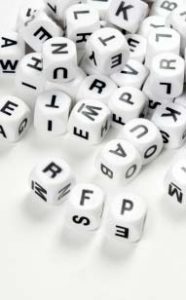 This is one of the few tradeshow exhibit industry terms that is also pretty common in other areas of business. In a nutshell, it means that your company has a need to buy products or services and you’d like to invite prospective vendors to submit proposals. RFPs can be sent out for something as simple as a rental backwall display or as elaborate as complete multi-year management of a hundred shows per year tradeshow program.
This is one of the few tradeshow exhibit industry terms that is also pretty common in other areas of business. In a nutshell, it means that your company has a need to buy products or services and you’d like to invite prospective vendors to submit proposals. RFPs can be sent out for something as simple as a rental backwall display or as elaborate as complete multi-year management of a hundred shows per year tradeshow program.
Once received, evaluation of submitted proposals can be difficult and time-consuming. As such, the number of companies that you invite should be limited to 3 – 5.
The basic RFP format is to provide:
- An overview of your company.
- A summary of your needs.
- An outline of how and when proposals should be submitted.
In order to make the process as efficient as possible, it is best to provide information that is concise. The key to dealing with responses in a timely fashion is to direct submissions so they are as similar in format as possible.
If you intend to request custom exhibit designs from bidders, keep in mind that designs are presented in a variety of formats from renderings mounted on boards to web-based video productions. You should clearly communicate the presentation format you prefer. When requesting designs, providing a budget number will make the final evaluation process much more productive.
You should also provide a format for the cost portion of the proposals. This can be in the form of a spreadsheet included in your RFP to be filled out and returned, or even as simple as an itemized list. Including this information helps to clearly describe what cost elements are to be included in the proposal. Things like carpet, electrical service, vacuuming, floral or technical support are not always part of the RFP process.
The bottom line? Give prospective vendors enough information to put together a proposal that is complete and in a format that makes it easy to compare. Time spent editing and refining your RFP documents can result not only in significant time savings when the time comes to review submissions, but also more quality in responses.
Need Exhibit Management for your trade show? We are ready to earn your business. Let’s talk.
EXHIBIT ACRONYMS – What does an EAC Provide at a Trade Show?
Exhibitor Appointed Contractor is a Company or Individual that Works on the Tradeshow Floor
The letters EAC is one of the thousands of acronyms that can seem to exist only to confuse people with less than 5 years of experience in the tradeshow business. EAC stands for Exhibitor Appointed Contractor.
 An Exhibitor Appointed Contractor is a company or individual that works on the tradeshow floor providing any of a number of services that could also be ordered from the General Services Contractor. (Freeman, GES, etc.) There are a few services for which you may prefer to use someone other than the General Services Contractor (GSC) such as installation and dismantling labor, audio visual rentals and service, floral, etc.
An Exhibitor Appointed Contractor is a company or individual that works on the tradeshow floor providing any of a number of services that could also be ordered from the General Services Contractor. (Freeman, GES, etc.) There are a few services for which you may prefer to use someone other than the General Services Contractor (GSC) such as installation and dismantling labor, audio visual rentals and service, floral, etc.
If you choose to use an EAC, you must notify the show well in advance to allow them time to make sure your selected company is properly certified and insured. The form for this notification is in the show manual. Be sure to find the form and get it sent in as soon as you are able since the show generally requires at least 30 days notice.
The most common service provided by an EAC is installation and dismantling labor. A large number of companies of all sizes are anxious to provide you with labor services. These companies claim to provide better quality labor and service than the GSC at a competitive price. They will also help you with filing the EAC form. Be sure to get their information in writing and check references just like you would with any of your vendors.
Installation and Dismantling of Your Tradeshow Exhibit Should be done by an EAC or GSC
There are some services that are provided only by the convention center or GSC such as material handling, electrical service and labor, rigging, vacuuming, plumbing, etc. Many exhibitors feel that this exclusivity allows the GSC to charge inflated rates or provide inferior labor, but for most of these services, there are good reasons for the rules. In the case of material handling or drayage, there must be only one exhibit management company organizing everything, both to keep order and for safety reasons. Electrical labor and service must be done according to the contract with the convention center and local building codes for public safety.
No matter who you choose to provide your needed services on the show floor, as a first step, you need to spend some time reading the show manual to understand each service and to know the rules and your rights. Need help? Let’s Talk.
Trade Show Exhibit Design: The Creative Brief
When you need to have a new trade show exhibit created, plan to discuss your schedule, budget, exhibit space, how frequently the booth will be used, and if there are any special requirements for the exhibit. If you want to create a breakthrough exhibit, also take the time to put together your creative requirements.
 Even some of my most organized clients rarely organize and formalize their creative requirements before they start working on a new trade show exhibit. They generally start by providing some basic verbal instructions about the design requirements. Then spend a lot of time gathering information in response to questions from the creative team.
Even some of my most organized clients rarely organize and formalize their creative requirements before they start working on a new trade show exhibit. They generally start by providing some basic verbal instructions about the design requirements. Then spend a lot of time gathering information in response to questions from the creative team.
Letting your vendor work solely from verbal input is the best way to waste time and money. Sometimes it results in a flashy but generic exhibit, and communications disconnects. On the other hand, if you work with your design firm to create a formal creative brief, you are well on your way to creating an exhibit that fully represents your brand and engages your target customer, and makes you look like a pro.
Look for a partner who will collaborate with you and create a formal brief – a succinct statement of what you are trying to accomplish and communicate with your new trade show exhibit. Once you have a formal brief, it’s easy to run it by key stakeholders and make sure that you are on the right track. It also serves as a guide for the creative team so that they clearly understand their mission.
Most of what you need to provide is probably readily available. A few phone calls or quick visits with co-workers and you will have most of the answers. The format that you use really doesn’t matter. Just gather the answers to the key questions and work with your exhibit marketing company to create a brief.
Here’s a list of preliminary questions that I have found are a useful starting point:
Brand and Company Mission:
What is your brand position?
What is your corporate mission?
These are usually brief formal statements that are prepared by the Marketing Department.
Background:
What do you want to achieve with the exhibit?
How will you measure the success of your trade show effort?
What’s going on in the market? Any opportunities or problems in the market?
Your Target Customer:
Who is your target customer?
What should be avoided in talking to this audience?
What do they believe about your company before we tell them anything?
Is there an important secondary audience?
The Message:
If you could get one sentence through all the clutter, what would that be?
If they asked you to prove it, how would you do that?
Are there any other major points do you want to communicate?
Be critical and honest about the answers to these questions. It is great to focus on your company’s strengths but it is also important to make sure the creative team knows your company’s weaknesses and challenges.
Once you have the answers, work with your exhibit design firm to develop a creative brief that provides a clear statement of expectations and lay out a clear framework for the creative team. I have found that the most effective creative briefs result from a collaboration between the client and their design team.
Do you have a collaborative relationship with your trade show exhibit design firm? Do you think it matters?
Archives
- July 2021
- June 2021
- May 2021
- April 2021
- October 2018
- September 2018
- August 2018
- July 2018
- June 2018
- May 2018
- April 2018
- March 2018
- February 2018
- January 2018
- December 2017
- November 2017
- October 2017
- September 2017
- August 2017
- July 2017
- June 2017
- May 2017
- April 2017
- March 2017
- February 2017
- January 2017
- December 2016
- November 2016
- October 2016
- September 2016
- August 2016
- July 2016
- June 2016
- May 2016
- April 2016
- March 2016
